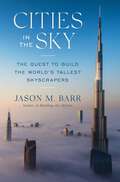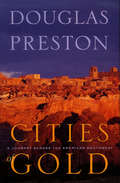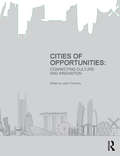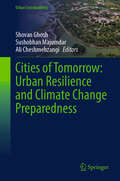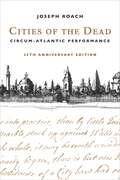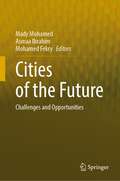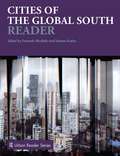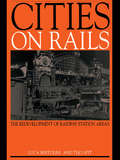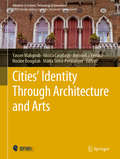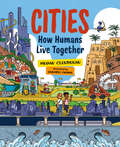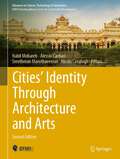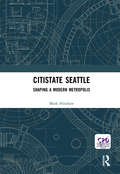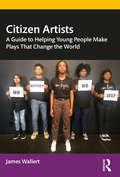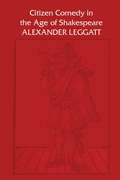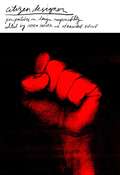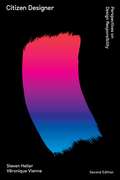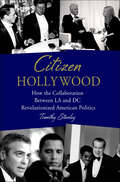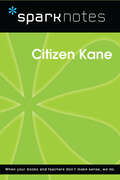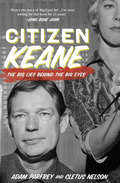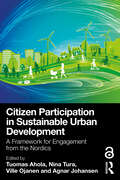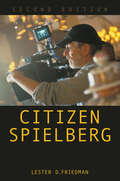- Table View
- List View
Cities in the Pre-Modern Islamic World: The Urban Impact of Religion, State and Society (SOAS/Routledge Studies on the Middle East #3)
by Amira K. Bennison Alison L. GascoigneThis volume is an inter-disciplinary endeavour which brings together recent research on aspects of urban life and structure by architectural and textual historians and archaeologists, engendering exciting new perspectives on urban life in the pre-modern Islamic world. Its objective is to move beyond the long-standing debate on whether an ‘Islamic city’ existed in the pre-modern era and focus instead upon the ways in which religion may (or may not) have influenced the physical structure of cities and the daily lives of their inhabitants. It approaches this topic from three different but inter-related perspectives: the genesis of ‘Islamic cities’ in fact and fiction; the impact of Muslim rulers upon urban planning and development; and the degree to which a religious ethos affected the provision of public services. Chronologically and geographically wide-ranging, the volume examines thought-provoking case studies from seventh-century Syria to seventeenth-century Mughal India by established and new scholars in the field, in addition to chapters on urban sites in Spain, Morocco, Egypt and Central Asia. Cities in the Pre-Modern Islamic World will be of considerable interest to academics and students working on the archaeology, history and urbanism of the Middle East as well as those with more general interests in urban archaeology and urbanism.
Cities in the Sky: The Quest to Build the World's Tallest Skyscrapers
by Jason M. BarrFrom one of the world&’s top experts on the economics of skyscrapers—a fascinating account of the ever-growing quest for super tall buildings across the globe.The world&’s skyscrapers have brought us awe and wonder, and yet they remain controversial—for their high costs, shadows, and overt grandiosity. But, decade by decade, they keep getting higher and higher. What is driving this global building spree of epic proportions? In Cities in the Sky, author Jason Barr explains all: why they appeal to cities and nations, how they get financed, why they succeed economically, and how they change a city&’s skyline and enable the world&’s greatest metropolises to thrive in the 21st century. From the Empire State Building (1,250 feet) to the Shanghai Tower (2,073 feet) and everywhere in between, Barr explains the unique architectural and engineering efforts that led to the creation of each. Along the way, Barr visits and unpacks some surprising myths about the earliest skyscrapers and the growth of American skylines after World War II, which incorporated a new suite of technologies that spread to the rest of the world in the 1990s. Barr also explores why London banned skyscrapers at the end of the 19th century but then embraced them in the 21st and explains how Hong Kong created the densest cluster of skyscrapers on the planet. Also covered is the dramatic result of China&’s &“skyscraper fever&” and then on to the Arabian Peninsula to see what drove Dubai to build the world&’s tallest building, the Burj Khalifa, which at 2,717 feet, is higher than the new One World Trade Center in New York by three football fields. Filled with fascinating details for urbanists, architecture buffs, and urban design enthusiasts alike, Cities in the Sky addresses the good, bad, and ugly for cities that have embraced vertical skylines and offers us a glimpse to the future to see whether cities around the world will continue their journey ever upwards.
Cities of Gold
by Douglas Preston Walter W. NelsonThis new ebook edition of Cities of Gold includes for very first time over 100 never-before-published photographs taken during the author's epic, thousand mile horseback journey across Arizona and New Mexico. It also includes many rare and extraordinary historical photographs of the Old West, Native Americans, pioneers, prospectors, Indian pueblos, and vanished landscapes. "The Old West's last glimmers flicker through this piercingly beautiful adventure, an unforgettable saga in which Preston, astride his horse Popeye, traverses the desert and mountain wilderness of Arizona and New Mexico retracing the trail-blazing 1540-41 expedition of Spanish Explorer Francisco Vasquez de Coronado in search of the legendary Seven Cities of Gold ... In place of the mythical winning of the West, Preston unfolds a harrowing tale of loss." - Publishers Weekly"The entire book is a sheer pleasure to read." - The San Diego Union-Tribune"A Blue Highways on horseback, well worth the trip." - Kirkus Reviews"A riveting yarn, with as many turns as a switchback road." - The Christian Science Monitor"A fearful, fascinating tale." - Los Angeles Times"A journey of historical importance." - The New York Times"By setting out with a companion and four horses to track Coronado's army across a thousand miles of brutal desert and mountain country, from the Mexican border through Arizona and New Mexico, the author is ready to risk his life to try to see with his own eyes, as it were, 'that moment, 450 years ago, when the peoples of the Old World and New World first encountered each other' and quickly began the strife-torn redefining of America. Throughout the book, Preston intersperses the original reports and memoirs of Coronado's adventure with accounts of his own party's hard progress, making the centuries dissolve into a common, first-person, present-tense narrative. And along the way he records stories of the people and places he encounters, making brief excursions into mining booms and busts, the history of livestock ranching, the impact of barbed wire and windmills, the first mail routes, homesteading, the destruction of the Indian nations, and much more." - Smithsonian MagazineDouglas Preston is a journalist and author who has published twenty-six books, nonfiction and fiction, several of which have been #1 New York Times bestsellers. In addition to Cities of Gold he is the author of several books on Southwestern history, including Talking to the Ground and The Royal Road. Preston is the co-creator, with Lincoln Child, of the Pendergast series of novels, including Relic and The Cabinet of Curiosities-both of which were named in a National Public Radio listener poll as being among the 100 greatest suspense novels ever written. Preston's most recent nonfiction book, The Monster of Florence, is being made into a movie starring George Clooney. Preston also writes for the New Yorker magazine, the Atlantic and Smithsonian, and he taught nonfiction writing at Princeton University. He divides his time between Maine and New Mexico.Walter W. Nelson began his creative career in 1967 and it has spanned a period of 40 years. He first explored the field of photography, traveling around the world, discovering spiritual places, deep landscapes, places of origin, experimenting with abstract colors and textures, always seeking the visual heart of existence in the desert, mountains, canyons, rivers, and cities of the world. He later branched out to painting and sculpture, and combined all three into an ever-expanding visual tapestry of mind and consciousness. "My life and my art," Nelson wrote, "is a constant journey into the unknown, always looking ahead, never behind, a positive and spiritual quest to understand and portray inner and outer existence." Nelson's work has been collected by many museums, including the Museum of New Mexico, the Albuquerque Museum of Art, The San Diego Museum of Photography, the Houston Museum of Fine Arts, the New Orleans Museum of Art, and Stanford University. It is also represented in a number of corporate collections including Coca...
Cities of Opportunities: Connecting Culture and Innovation
by Jason PomeroyCulture refers to not only the arts but also other manifestations of human intellectual achievement regarded collectively. It similarly refers to the customs, institutions, and achievements of a social group, a people, or a nation. Innovation refers to the action or process of change, alteration, or revolution; a new method of idea creation or product that may bring about change. It is easy to assume that innovation may be juxtaposed to the preservation of culture and time-tested rituals. Yet as human settlements grew; and as streets and squares evolved through the diverse exchanges of people trading, celebrating, rallying and socially interacting, it should come as little surprise that cities and its places would become, and continue to be, centres of culture and innovation that can be inextricably linked. Culture and Innovation in cities can potentially take on different complexions if viewed through the lens of academics and practitioners drawn from different geographies, disciplines, or fields of expertise when addressing particular urban challenges. It is through this complexity of views that this book seeks to provide a broad perspective on culture and innovation in the context of global cities today; and a rich cornucopia of insights from thought leaders within their respective fields to shape the cities of tomorrow.
Cities of Tomorrow: Urban Resilience and Climate Change Preparedness (Urban Sustainability)
by Ali Cheshmehzangi Sushobhan Majumdar Shovan GhoshThis book takes a comprehensive and forward-looking approach to urban resilience and climate change preparedness. It combines theoretical insights, practical case studies and innovative strategies to address the complex challenges cities face in an era of rapid urbanisation and changing climate patterns. It presents a fresh and innovative approach to addressing the intertwined challenges of urban resilience and climate change preparedness. What sets this book apart is its emphasis on forward-looking strategies, multidisciplinary insights and a comprehensive exploration of cutting-edge technologies and collaborative approaches. This book is likely to be diverse, encompassing professionals, academics, researchers, policymakers, practitioners, students and individuals interested in the fields of urban planning, environmental science, sustainability, climate change adaptation and related disciplines. The book aims to appeal to both experts in the field and those new to the subject, providing a valuable resource for different audiences.
Cities of the Dead: Circum-Atlantic Performance (The\social Foundations Of Aesthetic Forms Ser.)
by Joseph RoachIn the early eighteenth century, a delegation of Iroquois visited Britain, exciting the imagination of the London crowds with images of the “feathered people” and warlike “Mohocks.” Today, performing in a popular Afrodiasporic tradition, “Mardi Gras Indians” or “Black Masking Indians” take to the streets of New Orleans at carnival time and for weeks thereafter, parading in handmade “suits” resplendent with beadwork and feathers. What do these seemingly disparate strands of culture share over three centuries and several thousand miles of ocean?Interweaving theatrical, musical, and ritual performance along the Atlantic rim from the eighteenth century to the present, Cities of the Dead explores a rich continuum of cultural exchange that imaginatively reinvents, recreates, and restores history. Joseph Roach reveals how performance can revise the unwritten past, comparing patterns of remembrance and forgetting in how communities forge their identities and imagine their futures. He examines the syncretic performance traditions of Europe, Africa, and the Americas in the urban sites of London and New Orleans, through social events ranging from burials to sacrifices, auctions to parades, encompassing traditions as diverse as Haitian Voudon and British funerals. Considering processes of substitution, or surrogation, as enacted in performance, Roach demonstrates the ways in which people and cultures fill the voids left by death and departure.The twenty-fifth anniversary edition of this classic work features a new preface reflecting on the relevance of its arguments to the politics of performance and performance in contemporary politics.
Cities of the Future: Challenges and Opportunities
by Asmaa Ibrahim Mady Mohamed Mohamed FekryThis book seeks to address the key challenges and opportunities of "future cities" embracing novel approaches and grounded technologies in pursuing a vision for smart, inclusive cities. The objective of this book is to discuss multiple areas at the local, national, and international levels and how these challenges can hinder the development objectives planned to be achieved by the cities of the future. The chapters featured in this collection were presented at the 6th Memaryat International Conference (MIC 2022), held at the Effat University, Jeddah. MIC’s objective is to build bridges between science, technology, and innovation, seen as the key levers of attaining the SDGs.This book provides the most innovative ideas presented at the conference to address the key manifestation of “future cities" to embrace novel approaches and grounded technologies in the pursue of a vision for smart inclusive cities. It thus represents a platform for diverse contributions from academics and practitioners to present their different perspectives addressed theoretically as well as in practice concerning the challenges and opportunities of future cities. This includes contributions from decision-makers, architects, urban planners, urban designers, entrepreneurs, and educators to stimulate discussion covering the latest on the challenges and opportunities for better future cities in the different domains of architecture, building science and technology, environmental design, mobility & infrastructure, urban design & landscape, housing & real estate developments, urban planning, governance, socio-cultural & economic development, community engagement, tourism and heritage revitalization.
Cities of the Global South Reader (Routledge Urban Reader Series)
by Faranak Miraftab and Neema KudvaThe Cities of the Global South Reader adopts a fresh and critical approach to the fi eld of urbanization in the developing world. The Reader incorporates both early and emerging debates about the diverse trajectories of urbanization processes in the context of the restructured global alignments in the last three decades. Emphasizing the historical legacies of colonialism, the Reader recognizes the entanglement of conditions and concepts often understood in binary relations: first/third worlds, wealth/poverty, development/underdevelopment, and inclusion/exclusion. By asking: “whose city? whose development?” the Reader rigorously highlights the fractures along lines of class, race, gender, and other socially and spatially constructed hierarchies in global South cities. The Reader’s thematic structure, where editorial introductions accompany selected texts, examines the issues and concerns that urban dwellers, planners, and policy makers face in the contemporary world. These include the urban economy, housing, basic services, infrastructure, the role of non-state civil society-based actors, planned interventions and contestations, the role of diaspora capital, the looming problem of adapting to climate change, and the increasing spectre of violence in a post 9/11 transnational world. The Cities of the Global South Reader pulls together a diverse set of readings from scholars across the world, some of which have been written specially for the volume, to provide an essential resource for a broad interdisciplinary readership at undergraduate and postgraduate levels in urban geography, urban sociology, and urban planning as well as disciplines related to international and development studies. Editorial commentaries that introduce the central issues for each theme summarize the state of the field and outline an associated bibliography. They will be of particular value for lecturers, students, and researchers, making the Cities of the Global South Reader a key text for those interested in understanding contemporary urbanization processes.
Cities of the Golden Age: The Views of Anton Van den Wyngaerde
by Richard L. KaganIn the sixteenth century Spain was at the height of its glory, enjoying a period of exceptional power, wealth, and artistic splendor. In 1561 Philip II commissioned Europe's leading topographical artist, Anton van den Wyngaerde, to prepare cities and towns of his Golden Age empire. Van den Wyngaerde spent most of his time traveling in Spain from 1561 until his death in 1571, preparing views—many the earliest known depictions—of no fewer than sixty-two cities and towns, including Barcelona, Valencia, Zaragoza, Granada, Córoba, Seville, Toledo, Burgos, and Madrid. These drawings not only record Spain's cities during the most glorious moments in their history but also depict them with a precision that can almost be described as photographic.
Cities on Rails: The Redevelopment of Railway Stations and their Surroundings
by Luca Bertolini Tejo SpitThe development of railway stations and their surroundings is an emerging feature in current urban projects. Based on a series of the most inspiring contemporary European examples of station redevelopment, this book will help planners and urban designers understand the specific and complex nature of station locations. Based on their extensive research, the authors, pioneers of studies in the field in the last few years, harness and expand the body of knowledge and present guiding principles and conditions for successful implementation of such planning projects.
Cities' Identity Through Architecture and Arts: Proceedings Of The International Conference On Cities' Identity Through Architecture And Arts (citaa 2017), May 11-13, 2017, Cairo, Egypt (Advances in Science, Technology & Innovation)
by Hocine Bougdah Antonella Versaci Nicola Cavalagli Yasser Mahgoub Marta Serra-PermanyerThis book covers a broad range of topics relating to architecture and urban design, such as the conservation of cities’ culture and identity through design and planning processes, various ideologies and approaches to achieving more sustainable cities while retaining their identities, and strategies to help cities advertise themselves on the global market.Every city has its own unique identity, which is revealed through its physical and visual form. It is seen through the eyes of its inhabitants and visitors, and is where their collective memories are shaped. In turn, these factors affect tourism, education, culture & economic prosperity, in addition to other aspects, making a city’s identity one of its main assets.Cities’ identities are constructed and developed over time and are constantly evolving physically, culturally and sociologically. This book explains how architecture and the arts can embody the historical, cultural and economic characteristics of the city. It also demonstrates how cities’ memories play a vital role in preserving their physical and nonphysical heritage. Furthermore, it examines the transformation of cities and urban cultures, and investigates the various new approaches developed in contemporary arts and architecture.Given its scope, the book is a valuable resource for a variety of readers, including students, educators, researchers and practitioners in the fields of city planning, urban design, architecture and the arts.
Cities: How Humans Live Together (Orca Timeline #3)
by Megan ClendenanKey Selling Points Cities takes readers on a journey to more than 75 cities on six continents. It explores what makes a city sustainable and welcoming for today and tomorrow by introducing critical questions around urban citizenship, inclusivity and environmental and social justice. Includes fun and age-appropriate facts about public toilets, what cities used to look like and more. Links to numerous curriculum themes and has been vetted by experts in history, urban planning and environmental urban policy. Asks readers to think critically about how and why cities have evolved the way they have and how that should inform the cities of the future. The author did her graduate studies in environmental urban planning.
Cities’ Identity Through Architecture and Arts (Advances in Science, Technology & Innovation)
by Nabil Mohareb Nicola Cavalagli Sreetheran Maruthaveeran Alessio CardaciThis book presents works that book offer a novel interpretation of how today's urban problems can be tackled through the efficient use of resources and the modeling of solutions to best utilize the available features of cities. The second edition of this book compiles several research papers that present a detailed discussion of the formation and identification of cities and illustrate different case studies that deal with historical areas and buildings as part of preserving cities' vocabularies and self-identities. By unfolding a stimulating variety of topics in relation to the conservation of culture and identity, the book provides insights into planners and decision-makers, aiding them in their contributions to the implementation of the 2030 Sustainable Development goals with reference to heritage preservation.
Cities’ Vocabularies: The Influences and Formations (Advances in Science, Technology & Innovation)
by Nabil Mohareb Antonella Versaci Yasser Mahgoub Sreetheran Maruthaveeran Francesco AlbertiThis book discusses several topics regarding different vocabularies, such as sacred architecture, heritage buildings, open spaces, landmarks, and street escapes, all of which have a direct influence on the city form. The city form is also affected by the indirect impact of the citizens themselves, for example their culture, which in turn depends on the arts, as can be seen and embodied in morals, paintings, media, digital art, and sculpture. The book also examines the fundamental elements that are responsible for the identity of the city. Presenting case studies that demonstrate the how implementing the concept of the responsibility of architecture and arts affects the development of our cities, the book offers a new approach that is based on the available features of a city and explores how planners and decision-makers can use these features to address the myriad problems that our cities are facing.
Citistate Seattle: Shaping A Modern Metropolis
by Mark HinshawWith style and humor, the author writes of special places in everyday Seattle. The author takes us to popular, high-profile landmarks like Pike Place Market as well as tucked-away gems — cozy cottages, trendy pubs, gracious apartment buildings, and vibrant urban villages — that flavor and enliven the city. The author shares his eye for unique, humanizing details of design, architecture, and function, bringing this colorful metropolis to life so vividly you'll practically smell the coffee they brew and sell on (almost) every street corner. Along the way, the author explains the public and private decisions that helped Seattle avoid the urban desolation that plagues other American cities. The author introduces many of Seattle's movers and shakers — mayors, developers, artists, and urban pioneers — who took it upon themselves to guide metropolitan Seattle along a different path.
Citizen Artists: A Guide to Helping Young People Make Plays That Change the World
by James WallertCitizen Artists takes the reader on a journey through the process of producing, funding, researching, creating, rehearsing, directing, performing, and touring student-driven plays about social justice. The process at the heart of this book was developed from 2015–2021 at New York City’s award-winning Epic Theatre Ensemble with and for their youth ensemble: Epic NEXT. Author and Epic Co-Founder James Wallert shares his company’s unique, internationally recognized methodology for training young arts leaders in playwriting, inquiry-based research, verbatim theatre, devising, applied theatre, and performance. Readers will find four original plays, seven complete timed-to-the-minute lesson plans, 36 theatre arts exercises, and pages of practical advice from more than two dozen professional teaching artists to use for their own theatre making, arts instruction, or youth organizing. Citizen Artists is a one-of-a-kind resource for students interested in learning about theatre and social justice; educators interested in fostering learning environments that are more rigorous, democratic, and culturally-responsive; and artists interested in creating work for new audiences that is more inclusive, courageous, and anti-racist.
Citizen Comedy in the Age of Shakespeare (The Royal Society of Canada Special Publications)
by Alexander LeggattThis is the first book to survey comprehensively the field of Elizabethan and Jacobean citizen comedy. Most studies of the period focus on major authors; this one follows recurring themes and motifs, through a variety of plays by many authors from the moralizing comedies of the boys' companies. Professor Leggatt provides not only a fresh perspective on familiar plays by such figures as Jonson, Middleton, and Dekker, but also a new look at a number of neglected comedies, some by unfamiliar authors, some by major authors working together. Standard figures – the usurer, the prodigal, and the prostitute – and standard plots – notably intrigues based on money or sex (or both) – are traced to show the changes that occur in apparently stereotyped material at the hands of individual authors. The result is to display the range and internal variety of a genre that too often is seen as all of a piece, and to show the different ways in which social thinking can interact with the demands and comic form.This book will interest students of Renaissance English drama, both for its treatment of a neglected type of play and for its comments on individual citizen comedies. Those who are concerned with drama as a vehicle for social commentary will find many points for discussion.
Citizen Designer: Perspectives on Design Responsibility
by Steven Heller Veronique VienneWhat does it mean to be a designer in today's corporate-driven, overbranded global consumer culture? Citizen Designer attempts to answer this question with more than 70 debate-stirring essays and interviews espousing viewpoints ranging from the cultural and the political to the professional and the social. Edited by two prominent advocates of socially responsible design, this innovative reference responds to the tough questions today's designers continue to ask themselves: How can a designer affect social or political change? Can design become more than just a service to clients? At what point does a designer have to take responsibility for the client's actions? When should a designer take a stand?
Citizen Designer: Perspectives on Design Responsibility (Second Edition)
by Steven Heller Veronique VienneBalancing Social, Professional, and Artistic Views What does it mean to be a designer in today's corporate-driven, overbranded global consumer culture? Citizen Designer, Second Edition, attempts to answer this question with more than seventy debate-stirring essays and interviews espousing viewpoints ranging from the cultural and the political to the professional and the social. This new edition contains a collection of definitions and brief case studies on topics that today's citizen designers must consider, including new essays on social innovation, individual advocacy, group strategies, and living as an ethical designer. Edited by two prominent advocates of socially responsible design, this innovative reference responds to the tough questions today's designers continue to ask themselves, such as: How can a designer affect social or political change? Can design become more than just a service to clients? At what point does a designer have to take responsibility for the client's actions? When should a designer take a stand? Readers will find dozens of captivating insights and opinions on such important issues as reality branding, game design and school violence, advertising and exploitation, design as an environmental driving force, and much more. This candid guide encourages designers to carefully research their clients; become alert about corporate, political, and social developments; and design responsible products. Citizen Designer, Second Edition, includes insights on such contemporary topics as advertising of harmful products, branding to minors, and violence and game design. Readers are presented with an enticing mix of opinions in an appealing format that juxtaposes essays, interviews, and countless illustrations of "design citizenship."
Citizen Hollywood: How the Collaboration between LA and DC Revolutionized American Politics
by Timothy StanleyTo most Americans, Hollywood activism consists of self-obsessed movie stars promoting their pet causes, whether defending marijuana legalization or Second Amendment rights. There's some truth in that stereotype, and in this book you'll find the close personal friends of Fidel Castro, the wannabe cowboys, and the ever-ubiquitous Barbra Streisand. But Citizen Hollywood makes a far more serious case--that Hollywood's influence in Washington runs deeper and affects the country's government more than most of us imagine.Celebrity activism exerts a subtle power over the American political process, and that pressure is nothing new. Through money, networking, and image making, the movie industry has shaped the way that politics works for nearly a century. It has helped to forge a culture that is obsessed with celebrity and spectacle.In return, politicians have become part of the fabric of Hollywood society and cater to the wishes of their new-found friends and fund-raisers.Using original archival research and exclusive interviews with stars, directors, producers, and politicians from both parties, Timothy Stanley's Citizen Hollywood shows that the only way to understand the image-obsessed, volatile politics of modern America is to understand the hidden history of Hollywood's influence on Washington.
Citizen Kane (SparkNotes Film Guide)
by SparkNotesCitizen Kane (SparkNotes Film Guide) Making the reading experience fun! SparkNotes Film Guides are one-stop guides to great works of film–masterpieces that are the foundations of filmmaking and film studies. Inside each guide you&’ll find thorough, insightful overviews of films from a variety of genres, styles, and time periods. Each film guide contains:Information about the director and the context in which the film was made Thoughtful analysis of major characters Details about themes, motifs, and symbols Explanations of the most important lines of dialogue In-depth discussions about what makes a film so remarkable SparkNotes Film Guides are an invaluable resource for students or anyone who wants to gain a deeper understanding of the great films they know and love.
Citizen Keane
by Adam Parfrey Cletus NelsonTeary, big-eyed orphans and a multitude of trashy knockoffs epitomized American kitsch art as they clogged thrift stores for decades.When Adam Parfrey tracked down Walter Keane-the credited artist of the weepy waifs, for a San Diego Reader cover story in 1992-he discovered some shocking facts. Decades of lawsuits and countersuits revealed the reality that Keane was more of a con man than an artist, and that he forced his wife Margaret to sign his name to her own paintings. As a result, those weepy waifs may not have been as capricious an invention as they seemed.Parfrey's story was reprinted in Juxtapoz magazine and inspired a Margaret Keane exhibition at the Laguna Art Museum. And now director Tim Burton is filming a movie about the Keanes called Big Eyes, and it's scheduled for release in 2014. Burton's Ed Wood, starring Johnny Depp, was based upon the Feral House book edited and published by Parfrey about the angora sweater-wearing B-film director.Citizen Keane is a book-length expansion of Parfrey's original article, providing fascinating biographical and sociological details, photographs, color reproductions, and appendices with legal documents and pseudonymous essays by Tom Wolfe inflating big eye art to those painted by the great masters.
Citizen Participation in Sustainable Urban Development: A Framework for Engagement from the Nordics
by Agnar Johansen Tuomas Ahola Nina Tura Ville OjanenThis book assesses the ambitious goals for sustainability set by cities and nations and details ways to achieve those goals through effective forms of collaboration between citizens and multiple stakeholders, such as municipal decision-makers, entrepreneurs, and academic researchers.Each chapter discusses how citizens are currently involved in urban development and what opportunities there are for further deepening the collaboration in the context of urban development between citizens and municipalities. Cases from the Nordics focus on the adoption and use of digital technologies in the provision of municipal services as well as in citizen participation. The book presents the state of the art in scientific research in the field, practical examples from multiple case studies of sustainable urban development initiatives, as well as key themes for moving the discourse forward in the future. It is essential for academics, students, researchers, policymakers, urban planners, and professionals working in the areas of sustainability, urban development, and citizen engagement. It will also be relevant to citizen groups, community organisations, and activists who are interested in advocating for and participating in the development of smart and sustainable cities, particularly in Nordic countries.The Open Access version of this book, available at www.taylorfrancis.com, has been made available under a Creative Commons Attribution (CC-BY) 4.0 license.
Citizen Spectator
by Wendy BellionIn this richly illustrated study, the first book-length exploration of illusionistic art in the early United States, Wendy Bellion investigates Americans' experiences with material forms of visual deception and argues that encounters with illusory art shaped their understanding of knowledge, representation, and subjectivity between 1790 and 1825. Focusing on the work of the well-known Peale family and their Philadelphia Museum, as well as other Philadelphians, Bellion explores the range of illusions encountered in public spaces, from trompe l'oeil paintings and drawings at art exhibitions to ephemeral displays of phantasmagoria, "Invisible Ladies," and other spectacles of deception. Bellion reconstructs the elite and vernacular sites where such art and objects appeared and argues that early national exhibitions doubled as spaces of citizen formation. Within a post-Revolutionary culture troubled by the social and political consequences of deception, keen perception signified able citizenship. Setting illusions into dialogue with Enlightenment cultures of science, print, politics, and the senses, Citizen Spectator demonstrates that pictorial and optical illusions functioned to cultivate but also to confound discernment. Bellion reveals the equivocal nature of illusion during the early republic, mapping its changing forms and functions, and uncovers surprising links between early American art, culture, and citizenship.
Citizen Spielberg
by Lester D. FriedmanSteven Spielberg's extraordinary career redefined Hollywood, but his achievement goes far beyond shattered box office records. Rejecting the view of Spielberg as a Barnumesque purveyor of spectacle, Lester D. Friedman presents the filmmaker as a major artist who pairs an ongoing willingness to challenge himself with a widely recognized technical mastery. This new edition of Citizen Spielberg expands Friedman’s original analysis to include films of the 2010s like Lincoln and Ready Player One. Breaking down the works by genre, Friedman looks at essential aspects of Spielberg’s art, from his storytelling concerns and worldview to the uncanny connection with audiences that has powered his longtime influence as a cultural force. Friedman's examination reveals a sustained artistic vision--a vision that shows no sign of exhausting itself or audiences after Spielberg's nearly fifty years as a high-profile filmmaker. Incisive and discerning, Citizen Spielberg offers a career-spanning appraisal of a moviemaking icon.

